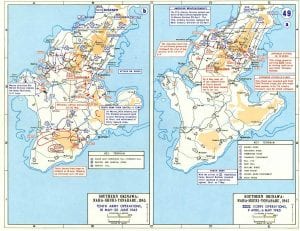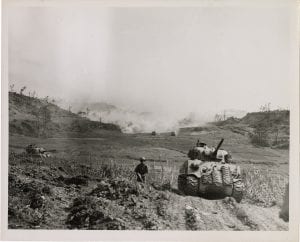
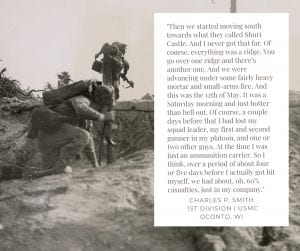
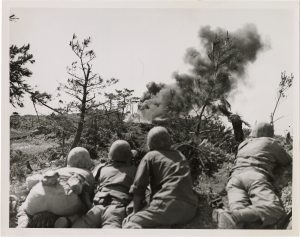
One hundred feet below Shuri Castle, in the tunnel that functioned as Ushijima’s headquarters, debate raged over whether to launch an offensive or stay on defense. Ushijima decided to attack with his reserve units in an effort to push back the Americans past Kakazu Ridge. In addition to the ground assault, two sea raiding groups of 500 men each would land behind Buckner’s lines on either side of Okinawa to create confusion. “Each soldier will kill one American devil,” the attackers were told.
On the night of May 3rd and into next morning, 125 planes of the Fifth Floating Chrysanthemum struck the Fifth Fleet. Under cover of the attacks Ushijima’s raiders started north; one group was caught by American patrol boats and annihilated, which the other lost its way and landed next to the 1st Marine Division, which eliminated it to a man. Just before dawn on May 4th, Japanese artillery fired 13,000 rounds into the American lines, followed by a massed assault against the 7th and 77th Infantry Divisions. American mortars and artillery tore into the attackers, in many places disrupting and stalling the advance. A renewed effort on May 5th resulted in 600 Japanese being cut off behind American lines for a time, where they were hunted down and all but 150 killed. Over 5,000 irreplaceable Japanese infantrymen had been lost for no gain. A tearful Ushijima pronounced the attack a complete failure. American troops continued to press forward as Buckner finished his regrouping. Buckner described the tactics to neutralize Japanese positions as “blowtorch [using fire and flamethrowers] and corkscrew [sealing with explosives].”
At noon on May 8th all guns on land and sea and fired three volleys to mark Germany’s surrender.
On May 11th, the next major American offensive began. Tenth Army faced the core of Ushijima’s defenses, and the Japanese were full of fight. The 1st Marine Division stormed Dakeshi Ridge in three days of fighting, followed by a push into the Wana Draw, opening a wedge into the Japanese positions. To their east, the 77th Infantry Division hammered against the ridges protecting Shuri Castle itself. On the ends of the line the Americans had the best success, as the 96th Infantry Division cleared Conical Hill in four days of fighting and the 6th Marine Division captured Sugar Loaf Hill after five days of back-and-forth battle. By May 20th the Marines were in Naha’s outskirts, while the 7thand 96th Infantry Divisions stood ready to sweep into 32d Army’s rear. Shuri’s defenses were crumbling.
Just before Tenth Army started its major offensive, the weather broke. Starting May 7th and lasting for 17 days, over 15 inches of rain drenched the battlefield. The clouds helped cover the Sixth Floating Chrysanthemum’s approach to Fifth Fleet. The Japanese struck Task Force 58’s flagship, USS Bunker Hill, resulting in serious damage and the near death of Admiral Mitscher. The admiral transferred to USS Enterprise, which was struck by suicide plane a few days later, forcing him to transfer yet again, to USS Randolph.
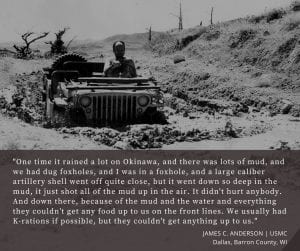
Photo from the Oliver Haessley collection. Photos from the top of the page from the Roberta Wells Leidner Collection.
Onshore, vehicles bogged, wet ammunition failed, and water and mud was everywhere. “The thick red dust that had covered the whole country,” recalled a Marine, “became a deep and gummy mud that which made motor movement most difficult.” The infantry continued to advance, but without tank support and supplies by truck, Tenth Army lost momentum. “Heavy rain has stopped our tanks,” recorded Buckner, “and is impeding supply just at a time when rapid progress . . . is most desirable.”
By May 21st, Ushijima realized he needed to make a decision. The American victories over the previous ten days threatened his army with encirclement. Ushijima considered fighting to the death at Shuri, but decided there were better prospects for prolonged resistance by retiring to Okinawa’s southern end. His forces started to move the night of May 22nd-23rd. American planes detected and attacked the retreating Japanese, but many observers thought the groups were Okinawan civilians and left them alone. Offshore, the Seventh and Eighth Floating Chrysanthemums attacked the fleet between May 23rd and 29th.
The Japanese rearguard kept up a bold enough front that for several days Tenth Army did not realize it was a general retreat. Once he understood, Buckner reacted swiftly. “Initiate without delay,” he ordered, “strong and unrelenting pressure to ascertain probable intentions and keep him off balance.” All units surged forward against desperate Japanese resistance. Shuri Castle fell to the 1st Marine Division on May 29th, and the surrounding heights were clear by May 31st.
The battle shifted southward, both armies sensing that an important moment had passed. “Ushijima missed the boat on his withdrawal from the Shuri Line,” announced Buckner to his staff. “It’s all over now but cleaning up pockets of resistance. This doesn’t mean there won’t be stiff fighting.”
